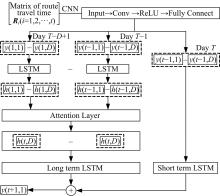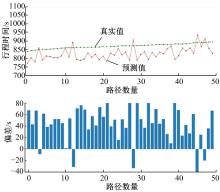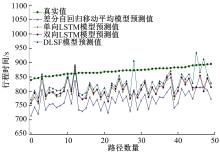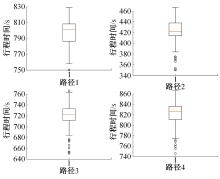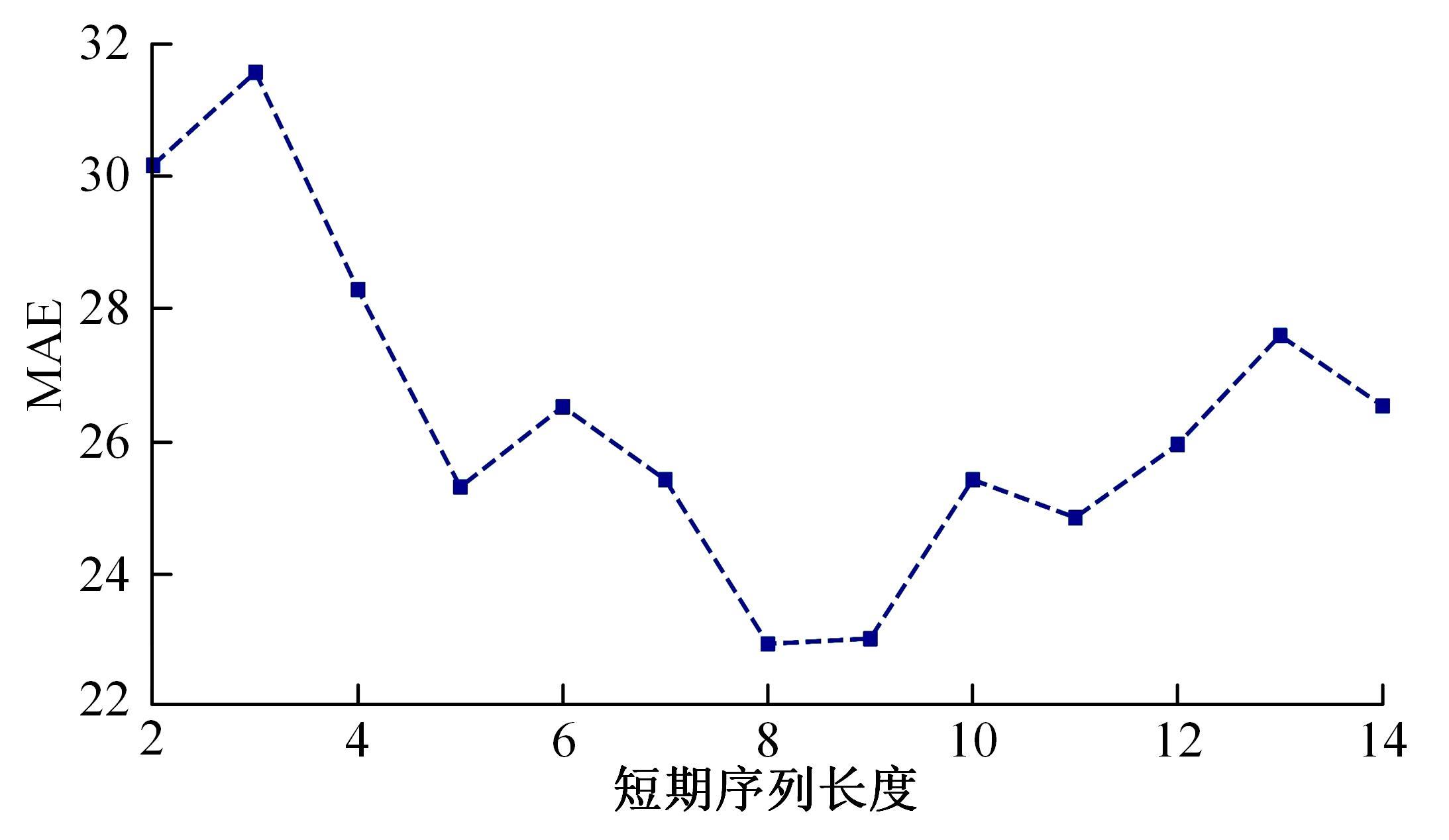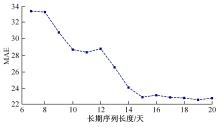吉林大学学报(工学版) ›› 2022, Vol. 52 ›› Issue (3): 557-563.doi: 10.13229/j.cnki.jdxbgxb20200803
• 交通运输工程·土木工程 • 上一篇
基于时空特征深度学习模型的路径行程时间预测
- 哈尔滨工业大学 交通科学与工程学院,哈尔滨 150001
Route travel time prediction on deep learning model through spatiotemporal features
Xian-tong LI( ),Wei QUAN,Hua WANG(
),Wei QUAN,Hua WANG( ),Peng-cheng SUN,Peng-jin AN,Yong-xing MAN
),Peng-cheng SUN,Peng-jin AN,Yong-xing MAN
- School of Transportation Science and Engineering,Harbin Institute of Technology,Harbin 150001,China
摘要:
针对路径行程时间预测问题,提出了一种时空特征深度学习网络模型,结合卷积神经网络(CNN)和长短时记忆网络(LSTM),并考虑了路段空间依赖、时序依赖以及粗颗粒度中的时间飘移问题,对下一时隙的路径行程时间进行了预测。利用哈尔滨市出租车轨迹数据为实验数据,比较发现基于时空特征深度学习网络模型比差分自回归移动平均模型在多个评价指标上均有提升,其中平均绝对误差(MAE)和R2指标分别提升了18.6%和22.46%。结果表明,本文模型的预测精度可达到90%以上,且效率处于同类模型的领先水平。
中图分类号:
- U491
| 1 | Yuan Y F, Hoogendoorm S, Kessels F, et al. Network-wide traffic state estimation using loop detector and floating car data[J]. Journal of Intelligent Transportation Systems, 2014, 18(1):41-50. |
| 2 | Liu H X, Ma Wen-teng. A virtual vehicle probe model for time-dependent travel time estimation on signalized arterials[J]. Transportation Research Part C: Emerging Technologies, 2009, 17(1): 11-26. |
| 3 | Box G E P, Jenkins G M, Reinsel G C, et al. Time Series Analysis: Forecasting and Control[M]. Hoboken, NJ: John Wiley & Sons, 2016. |
| 4 | Smith B L, Billy M W, Oswald R K. Comparison of parametric and nonparametric models for traffic flow forecasting[J]. Transportation Research Part C: Emerging Technologies, 2002, 10(4): 303-321. |
| 5 | Williams M B, Hoel L A. Modeling and forecasting vehicular traffic flow as a seasonal ARIMA process: theoretical basis and empirical results[J]. Journal of Transportation Engineering, 2003, 129(6): 664-672. |
| 6 | Zhang L, Liu Q C, Yang W C, et al. An improved k-nearest neighbor model for short-term traffic flow prediction[J]. Procedia-Social and Behavioral Sciences, 2013, 96: 653-662. |
| 7 | Chandra S R, Al-Deek H. Predictions of freeway traffic speeds and volumes using vector autoregressive models[J]. Journal of Intelligent Transportation Systems, 2009, 13(2): 53-72. |
| 8 | LeCun Y, Bengio Y, Hinton G. Deep learning[J]. Nature, 2015, 521(7553): 436-444. |
| 9 | Treiber M, Helbing D. Reconstructing the spatio-temporal traffic dynamics from stationary detector data[J/OL].[2020-09-25]. |
| 10 | 李月龙, 唐德华, 姜桂圆, 等. 基于维度加权的残差LSTM短期交通流量预测[J]. 计算机工程, 2019, 45(6): 1-5. |
| Li Yue-long, Tang De-hua, Jiang Gui-yuan, et al. Short term traffic flow forecasting based on dimension weighted residual LSTM[J]. Computer Engineering, 2019, 45(6):1-5. | |
| 11 | Bengio Y, Ducharme R, Vincent P, et al. A neural probabilistic language model[J]. Journal of Machine Learning Research, 2003, 3: 1137-1155. |
| 12 | Lecun Y, Bottou L, Bengio Y, et al. Gradient-based learning applied to document recognition[J]. Proceedings of the IEEE, 1998, 86(11): 2278-2324. |
| 13 | Zhang Jun-bo, Zheng Yu, Qi De-kang. Deep spatio-temporal residual networks for citywide crowd flows prediction[C]∥Thirty-First AAAI Conference on Artificial Intelligence, San Francisco, 2017: 1655-1661. |
| 14 | Yu R, Li Y, Shahabi C, et al. Deep learning: a generic approach for extreme condition traffic forecasting[J/OL].[2020-09-25]. |
| 15 | Yao Hua-xiu, Wu Fei, Ke Jin-tao, et al. Deep multi-view spatial-temporal network for taxi demand prediction[J/OL]. [2020-09-26]. |
| 16 | Yao Hua-xiu, Tang Xian-feng, Wei Hua, et al. Revisiting spatial-temporal similarity: A deep learning framework for traffic prediction[C]∥AAAI Conference on Artificial Intelligence, Honolulu, Hawaii, USA, 2019: 5568-5675. |
| 17 | 郭晟楠, 林友芳, 金文蔚, 等. 基于时空循环卷积网络的城市区域人口流量预测[J]. 计算机科学, 2019, 46(): 385-391. |
| Guo Sheng-nan, Lin You-fang, Jin Wen-wei, et al. Citywide crowd flows prediction based on spatio-temporal recurrent convolutional networks[J]. Computer Science, 2019, 46(Sup.1): 385-391. |
| [1] | 冯天军,孙学路,黄家盛,田秀娟,宋现敏. 基于三种过街方式的两相位信号交叉口延误[J]. 吉林大学学报(工学版), 2022, 52(3): 550-556. |
| [2] | 高文志,王彦军,王欣伟,张攀,李勇,董阳. 基于卷积神经网络的柴油机失火故障实时诊断[J]. 吉林大学学报(工学版), 2022, 52(2): 417-424. |
| [3] | 陈晓雷,孙永峰,李策,林冬梅. 基于卷积神经网络和双向长短期记忆的稳定抗噪声滚动轴承故障诊断[J]. 吉林大学学报(工学版), 2022, 52(2): 296-309. |
| [4] | 张龙,徐天鹏,王朝兵,易剑昱,甄灿壮. 基于卷积门控循环网络的齿轮箱故障诊断[J]. 吉林大学学报(工学版), 2022, 52(2): 368-376. |
| [5] | 段亮,宋春元,刘超,魏苇,吕成吉. 基于机器学习的高速列车轴承温度状态识别[J]. 吉林大学学报(工学版), 2022, 52(1): 53-62. |
| [6] | 薛锋,何传磊,黄倩,罗建. 多式轨道交通网络的耦合协调度[J]. 吉林大学学报(工学版), 2021, 51(6): 2040-2050. |
| [7] | 贾彦峰,曲大义,林璐,姚荣涵,马晓龙. 基于运行轨迹的网联混合车流速度协调控制[J]. 吉林大学学报(工学版), 2021, 51(6): 2051-2060. |
| [8] | 陆文琦,周天,谷远利,芮一康,冉斌. 基于张量分解理论的车道级交通流数据修复算法[J]. 吉林大学学报(工学版), 2021, 51(5): 1708-1715. |
| [9] | 钟辉,康恒,吕颖达,李振建,李红,欧阳若川. 基于注意力卷积神经网络的图像篡改定位算法[J]. 吉林大学学报(工学版), 2021, 51(5): 1838-1844. |
| [10] | 卢凯,吴蔚,林观荣,田鑫,徐建闽. 基于KNN回归的客运枢纽聚集人数组合预测方法[J]. 吉林大学学报(工学版), 2021, 51(4): 1241-1250. |
| [11] | 赵亚慧,杨飞扬,张振国,崔荣一. 基于强化学习和注意力机制的朝鲜语文本结构发现[J]. 吉林大学学报(工学版), 2021, 51(4): 1387-1395. |
| [12] | 王德兴,吴若有,袁红春,宫鹏,王越. 基于多尺度注意力融合和卷积神经网络的水下图像恢复[J]. 吉林大学学报(工学版), 2021, 51(4): 1396-1404. |
| [13] | 刘元宁,吴迪,朱晓冬,张齐贤,李双双,郭书君,王超. 基于YOLOv3改进的用户界面组件检测算法[J]. 吉林大学学报(工学版), 2021, 51(3): 1026-1033. |
| [14] | 彭博,张媛媛,王玉婷,唐聚,谢济铭. 基于自动编码机-分类器的视频交通状态自动识别[J]. 吉林大学学报(工学版), 2021, 51(3): 886-892. |
| [15] | 张健,吴坤润,杨敏,冉斌. 智能网联环境下交叉口双环自适应控制模型[J]. 吉林大学学报(工学版), 2021, 51(2): 541-548. |
|
||
